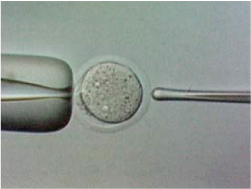A scientific“ flower” blooming in Fukushima

The sensor on the right detects whether an ovum is alive or dead.
Shin’ichiro Tomonaga was a joint winner of the 1965 Nobel Prize in Physics, and he once described science in these simple words.
“Thinking about a mystery is the bud from which science sprouts. Science’s stem is formed by observing carefully, confirming, and thinking. Then, when the mystery is solved, that is the flower of science.”
In order for a mystery to grow from a “bud” into a “stem,” we must ask questions and have a broad perspective. First, we ask ourselves what we need to do to explain the mystery, then we take inspiration from all fields, not only our own.
Associate Professor Yoshinobu Murayama of Nihon University is currently researching his own “bud” of a mystery, “What is life?” Part of that research is looking at the ovum. An ovum is a type of cell. Cells are the basic unit of life, and they hold molecules within a thin membrane. Inside an ovum, there is no control tower telling the parts what to do; before fertilization, the molecules inside just move around without any kind of order. However, when the sperm enters the ovum, the molecules inside begin to divide and grow, even though there is no central control. Professor Murayama is asking why these molecules in the ovum – which seem so disorganized – can work together and organize themselves into life. Life starts in the ovum when sperm is introduced, so looking into the order that appears after fertilization could give some understanding about life.
Professor Murayama says that the process inside the ovum – increased organization leading towards life – reminded him of distributed autonomous coordination technologies. When an electric company provides electricity to all the individual buildings of a town, it is controlling that distribution centrally. In contrast, in distributed autonomous coordination, electricity can be interchanged between adjacent homes and buildings, and the town as a whole stores enough energy to supply what is needed. We can get an idea of how molecules in an ovum move by thinking of individual houses and other buildings only considering the buildings closest to them. Professor Murayama is a part of the Department of Electrical and Electronic Engineering at College of Engineering, Nihon University, and that environment led him to come up with these ideas.
We live in a rapidly-changing world, so it is important to ask questions and have a broad point of view. Scientists take that to the extreme.
Ovum research is only part of what Professor Murayama is looking into. All of his other questions are also leading him to find his scientific “flower”.
What is life?

村山嘉延准教授(日本大学工学部電気電子工学科)
専門は医用生体工学、生体材料学、発生生物学。福島キャンパスにある次世代工学技術研究センターで、再生医療や生殖補助医療のための支援装置の開発や、超音波を用いた新しい診断・検査技術の開発など、工学技術の医療への応用を研究
している。